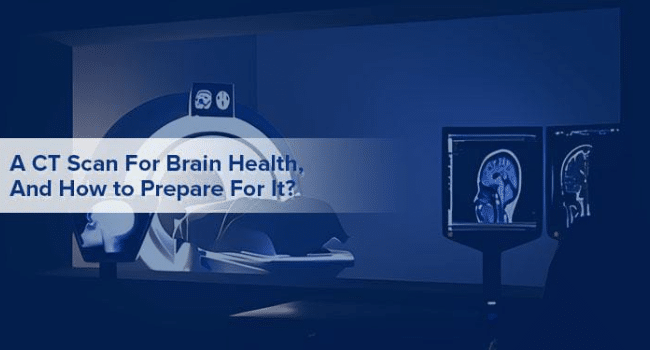Table of Contents
CT stands for computerised tomography also referred to as the CAT test. CT scan uses radiation and computers to generate and display the photos of the internals of your frame as an example of your coronary heart, brain, lungs and many others. Relying upon which a part of your body is being CT scanned. The images generated by the CT scan are in multiple planes. It can also generate 3 dimensional (3-D)images of your body as well.The scan images can show the internal organs, soft tissues and blood vessels, for a brain CT the scan images can appreciate detailed information for stroke, brain tumours or other brain diseases. CT scan images are more detailed and superior in quality than a traditional X-Ray.
What Are The Indications For A Head/Brain CT?
Your doctor might use a head CT to detect
- Any head injury leading to bleeding, brain injury or any skull fracture
- If a patient had a severe headache which lead to bleeding caused by a ruptured or leaking aneurysm
- A patient having symptoms of a stroke that can be appreciated as blood clots or bleeding within a brain
- A stroke, especially with a technique called CT perfusion of the head.
- For detecting any type of Brain tumours.
- In hydrocephalus patients, To visualise Enlarged brain cavities (ventricles) in patients .
- Any malformation or disease of the skull
- The cause of altered mental status in case of infection or infarct.
Your doctor might order head CT to
- To diagnose any hearing problem caused due to disease of temporal bone on the side of the skull.
- To visualise paranasal sinus inflammation or other changes
- Evaluate the extent of bone and soft tissue damage in the patients with facial trauma and plan surgical reconstruction.
- To diagnose first and then plan the radiotherapy treatment for any type of brain cancer and other soft tissue cancers
- To guide the path of a needle during needle biopsy for obtaining samples from the brain.
- To visualise and Assess aneurysms, types of AV malformations (arteriovenous malformations), and blood vessels by performing CT angiography.
- Headache in specific scenarios like –
- If a patient has a Sudden and severe headache, also known as thunderclap headache.
- To diagnose and visualise cancer
- If a New headache with papilledema is faced
- Any exciting activity such as sexual activity, exertion, or position
- Detecting any Neurologic deficit
- If a patient is Immunocompromised
- In case you are pregnant and facing headaches it should be checked
- Surgery related indication-
- MRi are helpful in guiding Surgery or preoperative planning
- For Postoperative evaluation after any major surgery
- Evaluation of surgical procedures such as for CSF Shunt malformation
- Detection of any Skull lesion such as tumours, fibrous dysplasia, paget disease, craniosynostosis.
- Detection and evaluation of any calcifications
- Dementia an be detected by imaging
- Head trauma in specific scenarios
- Acute head trauma, initial imaging-
- Imaging is done in Mild (GCS 13-15) after clinical evaluation
- Imaging is needed in case of Moderate or severe (GCS<13)
- For visualising and getting an idea of Penetrating trauma.
- Acute head trauma, short-term follow-up imaging,
- findings on imaging
- New or progressive neurological deficits
- Subacute or chronic traumatic brain injury with unexplained neurologic deficits.
- Certain head traumas which can cause cerebrospinal fluid (CSF) leak, initial imaging
- Acute ataxia caused by recent head trauma
- Paediatric abusive head trauma.
What to Prepare Before a CT scan?
If you are to undergo a CT scan, the instructions to follow are given by either your doctor or the healthcare provider some of them are-
- Clothing– you should wear loose and comfortable clothes , usually you are given a hospital gown to wear during the scan. Also you must now not have any jewelry on at the same time as scanning, higher to depart them at home.
- Contrast media– if a CT test is to be completed with evaluation dye you will be asked to signal a consent shape which says you understand the risks and blessings of the contrast dye and are comfortable to undergo it beneath supervision. The comparison may be administered via IV injection or may be given as an oral dose.
- Food and drink– if you are undergoing a NCCT or plain CT scan, you can drink and eat normally as you otherwise do,but if it is to be a contrast CT scan, you should not eat anything 3 hours before the test and only drink clear fluids
- Diabetes– if you are diabetic, you should eat a light meal 3 -4 hours prior to the scan. And you might be asked not to take your diabetic medication 48 hours after your scan depending on your health status
What Happens After A CT Scan?
If you had a contrast based CT scan,you might be asked to stay back for a few hours after the scan to monitor for any side effects or allergy. If you were given any medication or sedative before the scan, you will need someone else to take you home as you are not suggested to drive by yourself. If you develop any allergic reaction such as a rash,itching or redness after you reach home, you should immediately inform your doctor. Otherwise there are no specific guidelines to follow after a CT scan.
Summary
There are many diagnostic centres in delhi, india who offer a good diagnostic offers but the cost of a CT scan always worries a person, you can search for the best CT scan centre near you like Ganesh diagnostic who offer almost 50% off on brain CT Scan and other tests so that you can get a reliable result and in budget.
Read more on KulFiy
